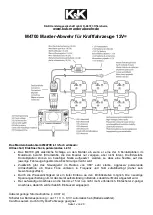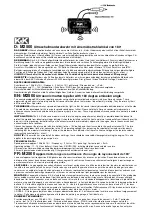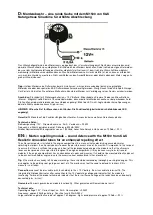
303-14-235
Electronic Engine Controls
303-14-235
DESCRIPTION AND OPERATION (
CONTINUED
)
E6692 EN
07/2001 2002 Bantam
Vehicles with 1.3L or 1.6L Engine
The sensors supply the PCM with input signals,
which relate to engine operating conditions and
the IAC valve responds to output signals from the
PCM. These output signals are based on the
evaluated input signals, which are compared with
calibrated data tables or maps before the output
signal is generated.
Powertrain Control Module (PCM)
The PCM is located inside the vehicle, behind the
left-hand cowl side trim panel and provides
precise control of basic engine calibration
parameters.
Crankshaft Position (CKP) Sensor
The CKP sensor is an inductive pulse generator,
which scans 36 minus one cast protrusions on
the flywheel. Minus one means that one of the
cast protrusions is missing. This missing cast
protrusion is located at 90º before top dead
center (TDC) and is used by the PCM as a
reference for crankshaft position. The CKP
sensor sends an alternating voltage signal to the
PCM where it is converted into the digital profile
ignition pick-up (PIP) signal.
Camshaft Position (CMP) Sensor
The CMP sensor is an inductive pulse generator,
which scans a reference cam on the camshaft. It
sends an alternating voltage signal to the PCM
from which the position and stroke of piston
number one is calculated. The signal from the
CMP sensor is required only during starting.
When the engine is running, the PIP signal is
used to sequentially control the fuel injectors.
Oxygen Sensor (O2S)
The O2S is a voltage generator, which is installed
ahead of the catalyst in the exhaust flow. When
the air/fuel ratio is ideal, theoretically 14.7:1
(lambda 1), a voltage signal is sent to the PCM.
When the mixture is lean, the voltage signal is
reduced and when the mixture is rich, the voltage
signal is increased. The PCM sets the air/fuel
mixture accordingly. This provides close control
of exhaust emissions.
Engine Coolant Temperature (ECT) Sensor
The ECT sensor is a temperature dependent
resistor, which has a negative temperature
coefficient. This means its resistance decreases
with increased temperature. It is supplied with a
reference voltage by the PCM. When the engine
coolant temperature changes, the resistance of
the ECT sensor changes therefore changing the
output voltage. The output voltage is assigned to
a corresponding engine coolant temperature by
the PCM.
Throttle Position (TP) Sensor
The TP sensor is a rotary variable resistor, which
is secured to the throttle body and operated by
the throttle plate shaft. It is supplied with a
reference voltage by the PCM. When the throttle
plate is opened, a sliding contact moves over a
resistance track changing the output voltage. The
output voltage is assigned to a corresponding
throttle plate position by the PCM.
Idle Air Control (IAC) Valve
The IAC valve is fitted directly into the intake
manifold. It is an electronically controlled solenoid
valve, which allows a flow of air to bypass the
throttle plate shaft. It is controlled by grounding
pulses from the PCM, the length of which
determines its position. Engine speed can
therefore be maintained irrespective of engine
load.
Temperature and Manifold Absolute Pressure (T-
MAP) Sensor
The T-MAP sensor is fitted directly into the intake
manifold and is therefore able to measure
vacuum accurately whilst the engine is running. It
consists of a pressure transducer and a
temperature sensor, which provide the PCM with
information relating to vacuum, barometric
pressure and air temperature within the intake
manifold. When the engine is running, it
measures vacuum and when the engine is not
running but the ignition is switched on, it
measures barometric pressure.
Knock Sensor (1.3L engine only)
The knock sensor is fitted to the engine to sense
the onset of engine knock and to return this
information to the engine control module, which
then can determine the optimum spark timing for
the engine. The engine control module will then
adjust the timing to reduce the tendency of
engine knock. This accurate discrimination of
combustion knocking allows engines to run
generally higher spark advance than has
previously been possible for improved power and
fuel economy.
















































